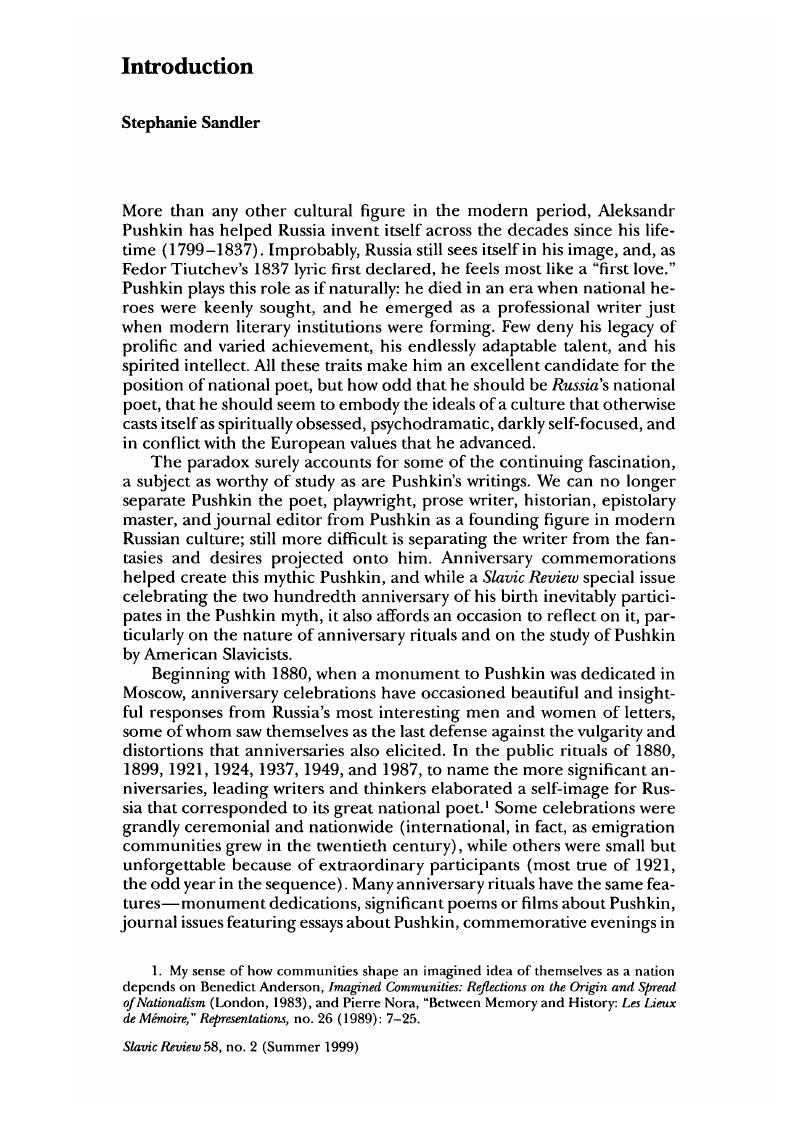No CrossRef data available.
Published online by Cambridge University Press: 27 January 2017

1. My sense of how communities shape an imagined idea of themselves as a nation depends on Anderson, Benedict, Imagined Communities: Reflections on the Origin and Spread of Nationalism (London, 1983)Google Scholar, and Nora, Pierre, “Between Memory and History: Les Lieux de Memoire ,” Representations, no. 26 (1989): 7–25.CrossRefGoogle Scholar
2. See Zoshchenko, Mikhail, “Shestaia povest’ I. P. Belkina,” Zvezda, 1937, no. 1: 25–32 Google Scholar; “V pushkinskie dni” (originally in Krokodil, 1937, no. 3) in Zoshchenko, Mikhail, Sobranie sochinenii, 3 vols. (Leningrad, 1986–1987), 2: 416–21Google Scholar. For an excellent structuralist analysis of Zoshchenko's use of Pushkinian and other subtexts in the Belkin tale, see Reyfman, Irina, “Shestaia povest’ Belkina: Mikhail Zoshchenko v role Proteiia,” in Gasparov, Boris, Hughes, Robert P., Paperno, Irina, eds., Cultural Mythologies of Russian Modernism: From the Golden Age to the Silver Age, California Slavic Studies, vol. 15 (Berkeley, 1992), 393–414.Google Scholar
3. Karen Petrone, “Life Has Become More Joyous, Comrades: Politics and Culture in Soviet Celebrations, 1934–1959” (Ph.D. diss., University of Michigan, 1994) includes a discussion of the resistance to Stalinist norms concealed in some of the celebration's speeches and publication.
4. Levitt, Marcus C., Russian Literary Politics and the Pushkin Celebration of 1880 (Ithaca, 1989), 4.Google Scholar
5. See Bitov, A. and Gabriadze, R., “Svobodu Pushkinu!” Sintaksis, 1990, no. 27: 167–75Google Scholar. They have also issued a limited edition of the first part of Pushkin za granitsei, Pushkin v Ispanii (Paris, [1989]). That edition indicates diat parts 2–4 of the series will take Pushkin to Paris, New York, and China; part 5 is “Pushkin and Dumas.” There is also a sequence on Pushkin in Georgia (1990), parts of which were published in Virolainen, M. N., ed., Legendy i mify o Pushkine (St. Petersburg, 1994), 303–18.Google Scholar
6. I limit the list to books in English. The list would be much longer if it included significant articles, of which there have been dozens, many of them never incorporated into later books, and if it included translations, which have long been a very important part of Pushkin scholars’ work in making the poet available to a broader audience. Also, beyond the mention of D. S. Mirsky's early book, I have not included books published in England, although of course many have been extremely influential, for example, John Bayley's 1971 study. I leave British books out regretfully, largely from the fear that my list would not be complete; moreover, for all the differences in tradition and training, British and American scholars have long been in very close touch, evidence of which is the inclusion of Wendy Slater's article in this volume.
7. Nora, Pierre, “The Era of Commemoration,” in his Realms of Memory: The Construction of the French Past, ed. Kritzman, Lawrence D., trans. Goldhammer, Arthur, 3 vols. (New York, 1996–98), 3: 614.Google Scholar
8. Ibid., 3: 609.
9. Engelstein, Laura, “Paradigms, Pathologies, and Other Clues to Russian Spiritual Culture: Some Post-Soviet Thoughts,” Slavic Review 57, no. 4 (Winter 1998): 864–77.CrossRefGoogle Scholar